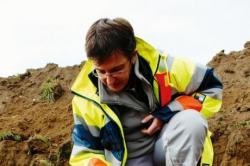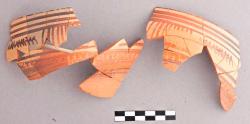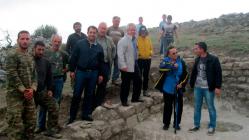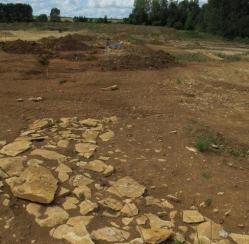INSTITUT SUPERIEUR D'ANTHROPOLOGIE
INSTITUTE OF ANTHROPOLOGY
ONLINE COURSES / COURS A DISTANCE
NEW OPEN COURSE : JANUARY 2013
HRM 104 : INTRODUCTION TO INTANGIBLE CULTURAL HERITAGE
REGISTER NOW
FRANCE –  Jonzac - C'est à la faveur des premiers coups de pelles nécessaires pour tracer l'emprise du rond-point d'accès au futur centre de congrès (1), sur la route de Champagnac à 200 mètres des Antilles, qu'une formidable découverte vient d'être faite : des silex taillés de belle qualité et en quantité, remontant à la période comprise entre l'aurignacien supérieur et moyen et le magdalénien moyen. Soit entre moins 30 000 et moins 15 000 ans. On est là dans le paléolithique, dans la période immédiatement postérieure au moustérien dont le site de fouilles voisin de Chez Pinaud, livra, entre 2004 et 2008, les traces de la vie sur nos terres de l'homme de Néandertal. Celui-là même qui vécut ici entre 70 000 et 35 000 ans avant le présent et qui précéda en somme ce que l'on appelle « l'homme anatomiquement moderne », entendez l'Homo sapiens. Avec ce gisement de silex taillés « d'une qualité exceptionnelle » selon Karine Robin, archéologue départementale, on se trouve ici dans une période plus « récente » donc. « On est là sur un gisement archéologique préhistorique, une aire de débitage de silex. On a trouvé de nombreux éclats et, ce qui est encore plus intéressant, de nombreux outils sous forme de lames taillées. Les niveaux de gisements sont intacts, en aucune façon perturbés par les occupations plus récentes. On ne connaît en France qu'un seul autre site ainsi préservé en l'état », indique la spécialiste. Sur moins de 20 mètres carrés seulement, environ 200 pièces de silex ont été prélevées pour rejoindre le dépôt de fouilles archéologiques de Saintes, en vue d'être soigneusement étudiées. Ce qui fait dire au sénateur-maire Claude Belot, « une découverte pareille, ça rend modeste. Car ce lieu voisin du site moustérien de Chez Pinaud, est habité depuis la nuit des temps. C'est une terre de limons dans une zone de résurgence des eaux. Et les limons ont tout conservé des occupations humaines successives ».
Jonzac - C'est à la faveur des premiers coups de pelles nécessaires pour tracer l'emprise du rond-point d'accès au futur centre de congrès (1), sur la route de Champagnac à 200 mètres des Antilles, qu'une formidable découverte vient d'être faite : des silex taillés de belle qualité et en quantité, remontant à la période comprise entre l'aurignacien supérieur et moyen et le magdalénien moyen. Soit entre moins 30 000 et moins 15 000 ans. On est là dans le paléolithique, dans la période immédiatement postérieure au moustérien dont le site de fouilles voisin de Chez Pinaud, livra, entre 2004 et 2008, les traces de la vie sur nos terres de l'homme de Néandertal. Celui-là même qui vécut ici entre 70 000 et 35 000 ans avant le présent et qui précéda en somme ce que l'on appelle « l'homme anatomiquement moderne », entendez l'Homo sapiens. Avec ce gisement de silex taillés « d'une qualité exceptionnelle » selon Karine Robin, archéologue départementale, on se trouve ici dans une période plus « récente » donc. « On est là sur un gisement archéologique préhistorique, une aire de débitage de silex. On a trouvé de nombreux éclats et, ce qui est encore plus intéressant, de nombreux outils sous forme de lames taillées. Les niveaux de gisements sont intacts, en aucune façon perturbés par les occupations plus récentes. On ne connaît en France qu'un seul autre site ainsi préservé en l'état », indique la spécialiste. Sur moins de 20 mètres carrés seulement, environ 200 pièces de silex ont été prélevées pour rejoindre le dépôt de fouilles archéologiques de Saintes, en vue d'être soigneusement étudiées. Ce qui fait dire au sénateur-maire Claude Belot, « une découverte pareille, ça rend modeste. Car ce lieu voisin du site moustérien de Chez Pinaud, est habité depuis la nuit des temps. C'est une terre de limons dans une zone de résurgence des eaux. Et les limons ont tout conservé des occupations humaines successives ».
http://www.sudouest.fr/2012/11/14/des-silex-tailles-vieux-de-30-000-a-15-000-ans-878032-1285.php
GRECE –  Methone - Recent excavations, ongoing since 2003-2004, have begun to bring to light ancient Methone in Pieria, ca 35 kilometers south of Thessaloniki. According to the ancient sources, testified by the archaeological finds, Methone was established by colonists from Eretria in Euboea around 733 BCE. Unique and so far unprecedented for Macedonia are the pots and potsherds unearthed from a rectangular pit, apparently used as an apothetes. The greatest majority of these sherds dates to ca 700 BCE, and 191 of them, recently pieced together, bear inscriptions, graffiti, and (trade)marks inscribed, incised, scratched and rarely painted, which are published by Matthaios Bessios, Yannis Tzifopoulos, and Antonis Kotsonas (http://ancdialects.greeklanguage.gr). Among these, an Euboean skyphos is by far the most impressive find. Incised on it, a curse addresses the potential thief. “I am Akesandros’ glass”, it declares, “(and whoever takes me) will lose his sight (or his money)”. According to Prof. Tzifopoulos, this epigram’s iambic trimeter seems to be the predecessor of another inscription, of an iambic rhythm as well, coming from Cymi, in Southern Italy, and dated between 675-650 BCE. “I am Tataies lekythos”, the text reads. “Whoever steals me (or steals it from me) will go blind”.
Methone - Recent excavations, ongoing since 2003-2004, have begun to bring to light ancient Methone in Pieria, ca 35 kilometers south of Thessaloniki. According to the ancient sources, testified by the archaeological finds, Methone was established by colonists from Eretria in Euboea around 733 BCE. Unique and so far unprecedented for Macedonia are the pots and potsherds unearthed from a rectangular pit, apparently used as an apothetes. The greatest majority of these sherds dates to ca 700 BCE, and 191 of them, recently pieced together, bear inscriptions, graffiti, and (trade)marks inscribed, incised, scratched and rarely painted, which are published by Matthaios Bessios, Yannis Tzifopoulos, and Antonis Kotsonas (http://ancdialects.greeklanguage.gr). Among these, an Euboean skyphos is by far the most impressive find. Incised on it, a curse addresses the potential thief. “I am Akesandros’ glass”, it declares, “(and whoever takes me) will lose his sight (or his money)”. According to Prof. Tzifopoulos, this epigram’s iambic trimeter seems to be the predecessor of another inscription, of an iambic rhythm as well, coming from Cymi, in Southern Italy, and dated between 675-650 BCE. “I am Tataies lekythos”, the text reads. “Whoever steals me (or steals it from me) will go blind”.
http://www.archaiologia.gr/en/blog/2012/11/14/a-curse-on-an-euboean-skyphos-ca-700-bc/
GRECE –  Koupos - An important archaeological excavation has just started at the “Koupos” site, by Krousona, not far from Herakleion (Crete). The site has been known since the early 20th century for the existence of an ancient city whose name remains unknown. The site has been first investigated by the 13th EPCA back in the 1980s. A large settlement came to light, inhabited from the Late Minoan to the Hellenistic years (1200-100 BC). Many Archaic buildings had well built rooms. Inside the rooms were found the stone bases of the wooden columns that used to hold the roof. Pits carved in the rock contained ceramics and other findings that seem to have been offered for the house’s solid foundations. Vases of special interest, vessels and tool equipment, lamps and animal figurines were found inside the buildings. Of particular importance is the sum of Archaic clay relief plaque representing female figures, richly dressed, standing or seated, as well as male figures and Satyrs. Special among them stand the clay plaques with a female figure in relief, most definitely a goddess, naked or dressed, wearing a high polos. The big part of a pithos neck, dating also from the 7th c., constitutes a unique finding: it is decorated with a repeated mythical theme that most probably depicts Clytemnestra’s murder by Orestes, in presence of Electra. Important ceramic and other objects testify this settlement’s life during the 8th c. BC as well. We know that the Koupos settlement has been inhabited since at least the mature Late Minoan IIIc time. At the other end, Hellenistic findings, such as ceramic and clay relief tablets, extend the settlement’s life to the 3rd and 2nd c. BC.
Koupos - An important archaeological excavation has just started at the “Koupos” site, by Krousona, not far from Herakleion (Crete). The site has been known since the early 20th century for the existence of an ancient city whose name remains unknown. The site has been first investigated by the 13th EPCA back in the 1980s. A large settlement came to light, inhabited from the Late Minoan to the Hellenistic years (1200-100 BC). Many Archaic buildings had well built rooms. Inside the rooms were found the stone bases of the wooden columns that used to hold the roof. Pits carved in the rock contained ceramics and other findings that seem to have been offered for the house’s solid foundations. Vases of special interest, vessels and tool equipment, lamps and animal figurines were found inside the buildings. Of particular importance is the sum of Archaic clay relief plaque representing female figures, richly dressed, standing or seated, as well as male figures and Satyrs. Special among them stand the clay plaques with a female figure in relief, most definitely a goddess, naked or dressed, wearing a high polos. The big part of a pithos neck, dating also from the 7th c., constitutes a unique finding: it is decorated with a repeated mythical theme that most probably depicts Clytemnestra’s murder by Orestes, in presence of Electra. Important ceramic and other objects testify this settlement’s life during the 8th c. BC as well. We know that the Koupos settlement has been inhabited since at least the mature Late Minoan IIIc time. At the other end, Hellenistic findings, such as ceramic and clay relief tablets, extend the settlement’s life to the 3rd and 2nd c. BC.
http://www.archaiologia.gr/en/
FRANCE –  Louzy et Sainte-Verge - Un établissement rural pérenne de l'Antiquité au Moyen Âge sur les communes de Sainte-Verge et Louzy. Il s'agit d'un endroit occupé depuis le néolithique. Ce site gallo-romain, organisé autour d'un axe de circulation antique, a ensuite été réoccupé à l'époque médiévale. Les fouilles, qui ont repris ces derniers jours et se poursuivent jusqu'au 27 novembre, ont notamment révélé des parties souterraines assez rares.
Louzy et Sainte-Verge - Un établissement rural pérenne de l'Antiquité au Moyen Âge sur les communes de Sainte-Verge et Louzy. Il s'agit d'un endroit occupé depuis le néolithique. Ce site gallo-romain, organisé autour d'un axe de circulation antique, a ensuite été réoccupé à l'époque médiévale. Les fouilles, qui ont repris ces derniers jours et se poursuivent jusqu'au 27 novembre, ont notamment révélé des parties souterraines assez rares.
http://www.lanouvellerepublique.fr/Toute-zone/Loisirs/Patrimoine-tourisme/n/Contenus/Articles/2012/11/14/Une-conference-tres-fouillee